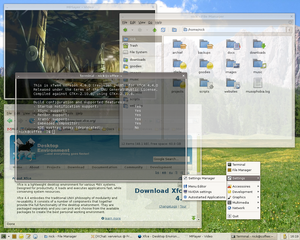The Xfce Desktop Environment is a complete desktop, file, session, window manager, and at the same time, unlike GNOME or KDE, Xfce components can be used individually and do not require each other.
Overview[]
XFCE is a lightweight, but full desktop environment. It runs very quickly on a system with as little as a 133MHz Pentium class processor and less than 64MB of RAM -- just like some, select window-only managers -- while providing full desktop, file and session management as well.
History[]
Olivier Fourdan started the project in 1996. The name "Xfce" originally stood for "XForms Common Environment", but since that time Xfce has been rewritten twice and no longer uses the XForms toolkit. The name survived, but it is no longer capitalized as "XFCE", but rather as "Xfce". The developers' current stance is that the initialism no longer stands for anything specific. It has been nicknamed "Cholesterol Free Desktop Environment", even in some of its man pages.
Early Versions[]
Xfce began as a simple project created with XForms, meant to be a free Linux clone of CDE.
Fourdan continued developing the project, and in 1998, Xfce 2 was released with the first version of Xfce's window manager, Xfwm. Xfce 2 was only distributed in Debian's contrib component.
In March 1999, Fourdan began a complete rewrite of the project based on GTK+, a non-proprietary toolkit whose popularity was increasing. The result was Xfce 3.0
Modern Xfce[]
Xfce 4.0.0, released September 25, 2003, was upgraded to the GTK+ 2 libraries. 4.2.0 included a compositing manager for Xfwm which added built-in support for transparency and drop shadows. In January 2007, 4.4.0 introduced the Thunar file manager, replacing the original Xffm. It also brought support for desktop icons, and fixed many panel bugs. In February 2009 Xfce 4.6.0 was released. This version had a new configuration backend, a new settings manager and a new sound mixer, as well as several significant improvements to the session manager and the rest of Xfce's core components.
In January 2011, Xfce 4.8.0 was released. This version included changes such as the replacement of ThunarVFS and HAL with GIO, udev, ConsoleKit and PolicyKit, and new utilities for browsing remote network shares using several protocols including SFTP, SMB, and FTP. Window clutter was reduced by merging all file progress dialog boxes into a single dialog. The panel application was also rewritten for better positioning, transparency, item and launcher management. 4.8 also introduced a new menu plugin to view directories. The 4.8 plugin framework remains compatible with 4.6 plugins. The display configuration dialog in 4.8 supports RandR 1.2, detecting screens automatically and allowing users to pick their preferred display resolution, refresh rate and display rotation.
The 4.8 development cycle was the first to use the new release strategy formed after the "Xfce Release and Development Model" developed at the Ubuntu Desktop Summit in May 2009. A new web application was employed to make release management easier, and a dedicated Transifex server was set up for Xfce translators. The project's server and mirroring infrastructure was also upgraded, partly to cope with anticipated demand following the release announcement for 4.8.
Xfce 4.10, released on 28 April 2012, introduced a vertical display mode for the panel and moved much of the documentation to an online wiki. The main focus of this release was on improving the user experience.
Xfce 4.12 was released on February 28, 2015, two years and ten months later, with improvements to further polish the user experience and take advantage of new technologies introduced in the interim. New window manager features include a new Alt+Tab dialog and smart multi-monitor handling. Also included are a new power management plugin for the panel's notification area, a new default text editor, and an enhanced file manager. With 4.12, the project reiterated its commitment to Unix (non-Linux) platforms, using OpenBSD to take screenshots.
Xfce 4.14 was released on 12 August, 2019, after 4 years and 5 months of development. The main goal was to port all core components to Gtk3 (over Gtk2) and GDBus (over D-Bus GLib). Most components also received GObject Introspection support. The window manager received several new updates and features, including support for VSync (using either Present or OpenGL as backend) to reduce or remove display flickering, HiDPI support, improved GLX support with NVIDIA proprietary/closed source drivers, support for XInput2, various compositor improvements and a new default theme. Thunar recieved several updates, including a reworked pathbar. Also included are several changes to Xfce "goodies", including the ability to move the selection rectangle within the screenshot application, and improved keyboard shortcut support within the clipboard manager. A new panel profiles application is included which allows users to save and manage several panel configurations, of which several are included.
Distributions[]
XFCE4 is included with most major distributions. Several distributions formally support XFCE as a standalone environment, including:
- Fedora 2+ -- XFCE is an official, standalone desktop environment starting with Fedora(TM) Core release 2 and can be enabled by default using the Desktop Switcher Tool. Additional XFCE4 components are provided in Fedora Extras (which is now a standard repository at installation starting with Fedora Core release 5).
- Xubuntu 6.06+
- Linux Mint XFCE - The Debian Edition of Linux Mint supports an XFCE as well as GNOME version. Before the release of Mint 11, an XFCE edition was released as a community edition to the main build.
- Crunchbang Linux - Supports Openbox by default, but with a choice of an Xfce version instead. (Discontinued)
Documentation[]
End-user documentation of the current XFCE 4.16 version can be found here.
Compatibility[]
XFCE4 is written using GTK+ 2 and completely compatible with GNOME 2 applications. It's desktop and window manager (xfwm4) is also compatible with the K Desktop Environment (KDE), Gnome, and the Rox-Filer session/file manager.

